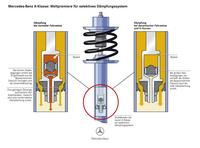Mercedes-Benz A-Class technology controls the shock absorbers according to the driving situation
Stuttgart, Oct 05, 2004 With a suspension system which has been further refined and improved in many respects, the new A-Class offers a combination of dynamic handling and typical Mercedes comfort previously unknown in this model series. This is in no small measure due to a standard-fitted selective damping system which celebrates its world premiere in this compact Mercedes car. It adapts the action of the shock absorbers to suit the driving situation. Soft shock absorber characteristics ensure a high level of ride comfort during normal driving, while the full damping action is made available for maximum stability when negotiating bends at speed. With this new development, which no other compact car currently features as standard, Mercedes-Benz has solved a well-known conflict of aims in suspension engineering in a simple yet highly effective manner: should the shock absorbers tend to be stiffer in the interests of handling safety and dynamic performance, or should their configuration be softer for greater comfort? Equipped with the selective damping system as standard, the new A-Class meets both requirements. It operates hydro-mechanically and requires no complex sensors or electronics.
In a conventional shock absorber, the damping effect is created when the movement of the road wheels causes oil to be squeezed through a valve in the shock absorber piston, with flexible valve discs providing the shock absorber’s resistance characteristics. In the new, selective damping system of the A-Class, a part of the oil flow is directed through an additional valve housing above the actual damper piston. Inside this there is a control plunger which divides the valve housing into two areas. When the shock absorber is subjected to only small movements, i.e. during normal driving, the control plunger is in a central position and holds open a bypass duct which allows part of the oil flow to pass through the piston journal. This oil flows past the damper valve, reducing the overall resistance of the shock absorber. This produces "softer" shock absorber characteristics for a high level of ride comfort.
If the shock absorber is subjected to more abrupt movements – for example when taking bends at speed or during evasive manoeuvres – the oil pushes the control plunger in the valve housing upwards or downwards, automatically closing the bypass duct. As a result the full damping effect becomes available and the A-Class is stabilised to the maximum.



